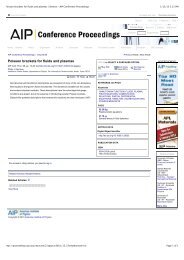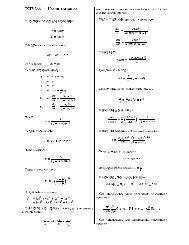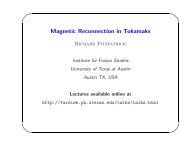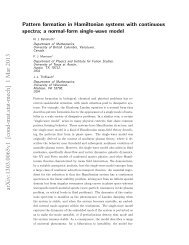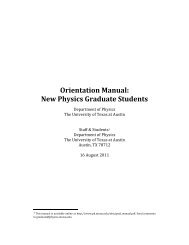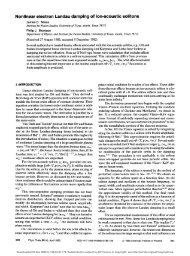Magnetic Fields and Magnetic Diagnostics for Tokamak Plasmas
Magnetic Fields and Magnetic Diagnostics for Tokamak Plasmas
Magnetic Fields and Magnetic Diagnostics for Tokamak Plasmas
You also want an ePaper? Increase the reach of your titles
YUMPU automatically turns print PDFs into web optimized ePapers that Google loves.
<strong>Magnetic</strong> fields <strong>and</strong> tokamak plasmas<br />
Alan Wootton<br />
From these two signals we can calculate δΦ. The subtractions are per<strong>for</strong>med electronically (i.e.<br />
analog); the constant k is determined experimentally so that δΦ is zero without plasma (toroidal<br />
field only).<br />
In reality there are problems. One in particular is caused by the discreteness of the toroidal field<br />
system, <strong>and</strong> the current redistribution in the toroidal field coils during a shot. When the toroidal<br />
field current is initiated, the current flows at the inner edge of the conductors to minimize the<br />
linked flux.<br />
As the pulse proceeds, the current redistributes <strong>and</strong> approximates a uni<strong>for</strong>m<br />
distribution (not exactly because of repulsion of current channels).<br />
The time <strong>for</strong> this<br />
redistribution to occur is approximately the radial penetration time of the poloidal current into the<br />
conductor of radial extent w: τ ≈ πµ 0 σw 2 /16, typically 200 ms. If the toroidal field system was a<br />
perfect toroidal solenoid this redistribution would leave the fields unaffected. However, because<br />
of the discrete number of toroidal fields, there is now a time varying toroidal field ripple. The<br />
size of the changing field ripple depends on where a pickup coil is placed: there<strong>for</strong>e two coils<br />
linking the same steady state flux can link different transient fluxes. It is best to place the coils<br />
between the toroidal field coils, where the redistribution effect is smallest.<br />
Another problem is due to poloidal eddy currents in any conducting vacuum vessel. This<br />
produces a non zero change in the toroidally averaged B φ , not just a local ripple. There<strong>for</strong>e it<br />
couples strongly to the pickup loops. Compensation <strong>for</strong> both the effects discussed has been<br />
per<strong>for</strong>med successfully using software, by simulating redistribution <strong>and</strong> eddy currents as simple<br />
circuits, coupled to both the primary B φ coil current <strong>and</strong> a secondary pickup coil.<br />
Further problems occur if the loops are not exactly positioned, so that they couple to the poloidal<br />
fields produced by the primary, vertical field <strong>and</strong> shaping windings. That any such effects exist<br />
can be checked <strong>for</strong> by firing discharges with positive (+) <strong>and</strong> negative (-) B φ . Let ∆Φ p be the<br />
signal caused by poloidal field coupling, ∆Φ(+) the signal obtained with positive B φ , <strong>and</strong> ∆Φ(-)<br />
the signal obtained with negative B φ . While the toroidal field coupling effects will change sign<br />
with reversing B φ , any poloidal field effects will not. There<strong>for</strong>e<br />
∆Φ ( + ) − ∆Φ ( −) = 2 δΦ + ∆Φ p<br />
( ) 14.27<br />
∆Φ ( + ) + ∆Φ ( −) = 2∆Φ<br />
p<br />
14.28<br />
Any finite ∆Φ p can be correct <strong>for</strong> using a circuit model again, with the coupling between any<br />
winding (including vacuum vessel) <strong>and</strong> the pickup coil written in terms of mutual inductances.<br />
112



